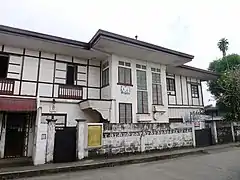Casa Bernedo
Casa Bernedo, also known as the Bernedo Ancestral House, is a two-storey ancestral house in Dipolog, Zamboanga del Norte in the Philippines.[1][2][3][4][5]
| Casa Bernedo | |
|---|---|
Balay Bernedo | |
 Casa Bernedo facing Arellano Street | |
.svg.png.webp) Location of Casa Bernedo in the Philippines | |
| Alternative names | Bernedo Ancestral House Dipolog City Center for the Culture and the Arts |
| General information | |
| Status | Complete |
| Type | Mansion |
| Location | Zamboanga del Norte |
| Address | Arellano Street corner Ranillo Street |
| Town or city | Dipolog |
| Country | Philippines |
| Coordinates | |
| Completed | Pre-20th Century |
| Owner | Bernedo-Macias family |
| Technical details | |
| Material |
|
| Floor count | 2 |
| Designations | Ancestral house |
History
The house was the residence of the then-influential Bernedo family of Dipolog. It was built by the turn of the 20th Century by a Spaniard named Justo Bernedo and his wife Isabel Macias, a Filipina from Dipolog, where they raised their nine children together. The Bernedo house largely retained its original structure, only undergoing a minor renovation shortly after the end of World War II. Known to be an influential and a religious family in Dipolog's earliest days, the Bernedos hosted numerous dignitaries and VIPs who visited Dipolog in the house,[6] including the town's Catholic church clergy and Philippine President Ramon Magsaysay.
Following the death of the last of the nine surviving Bernedo-Macias siblings in 2008, the Bernedo house was closed permanently. On July 1, 2012, the Bernedo house, now named Casa Bernedo, was reopened to the public as the Dipolog City Center for the Culture and the Arts in time for the city's centenary to be observed exactly a year later.[6]
The house today
Today, Casa Bernedo serves as a museum and art gallery. The lower floor, which was said to be a small storage house or warehouse (commonly known as a bodega), serves as a venue for visual art and photography exhibits.[7][8] Another room on the lower floor was utilized as a local gun store, until that space is currently occupied as the city's tourism office by the City Government of Dipolog.
The second floor, where the Bernedo-Macias family once lived, serves as a museum preserving the family house's interior and arrangements. The floors and their home appliances were all made out of Philippine hardwood, and their kitchen appliances were all imported from the United States. It was said that the kitchen, also on the upper floor, had a story on Dipolog becoming the Spanish sardine capital today when Isabel Macias Bernedo would make Spanish-styled sardines which she learned from her sister Concepcion Macias Montaño every summer. Casa Bernedo is open to the public free of charge.[2][3]
References
- "Family-friendly adventures in Dipolog: A 'Biyahe ni Drew' itinerary". GMA News Online. 24 June 2014. Retrieved 2 November 2020.
- Ong, Kenneth Irving (15 April 2014). "Dipolog's Casa Bernedo (page 12)". issuu.com. Edge Davao. Retrieved 2 November 2020.
- Ong, Kenneth Irving (15 April 2014). "Dipolog's Casa Bernedo (page 16)". issuu.com. Edge Davao. Retrieved 2 November 2020.
- "Murang pagkain at mayamang kultura ng Dipolog, tampok sa 'Biyahe ni Drew'". GMA News Online. 13 June 2014. Retrieved 2 November 2020.
- Salvador, Jinggoy I. (22 February 2014). "Ta ama yo contigo Zamboanga". SunStar. Retrieved 2 November 2020.
- Casa Bernedo (Marker). Casa Bernedo. n.d.
- Te, Maria Victoria Tenido (14 April 2019). "Mother-daughter tandem depicts 'essence' of women in art exhibit". Rappler. Retrieved 5 October 2020.
- Taghoy, Emmanuel D. (14 April 2019). "'Essence' art exhibit promotes women empowerment; showcases ZamPen indigenous culture". Philippine Information Agency. Archived from the original on 2 November 2020. Retrieved 2 November 2020.
